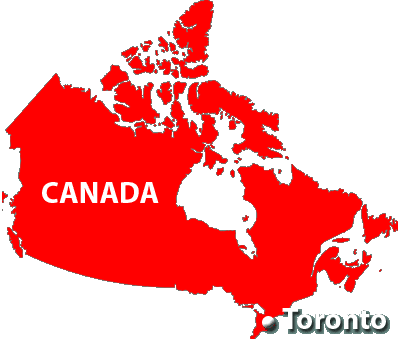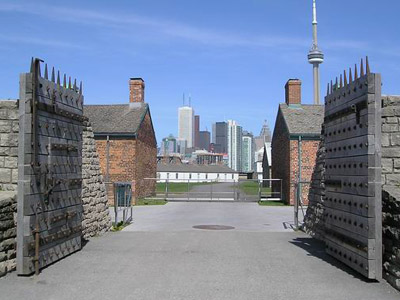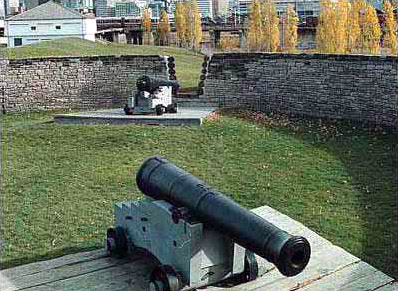 |
Fort York
Toronto, Canada
|
|
 |
The name Toronto is derived from the Iroquois word tkaronto, which translates as place where trees stand in the water. Planting saplings so they'll grow in water is an old Injun way to corral fish, but the Hurons chased off the Iroquois, and white folks came in the 16th century and chased off the Huron. Thank goodness, now the real history can begin!
Well, the Mississauga must have chased off the Hurons first, because it was from they that Great Britain negotiated the Toronto Purchase in 1787, buying a quarter million acres of land in the Toronto area for the many displaced Britishy persons who were flowing out of the United States during and after the American Revolution (1775-1783).
|
 |
 |
|
Lieutenant Governor of Upper Canada John Graves Simcoe (1752-1806) made the town of Niagra-on-the-Lake the capital of Upper Canada (this province is now Ontario) in 1792. This location, where the Niagra River joins Lake Ontario, seemed reasonable at the time, in that it was supported by Fort Mississauga...but just on the other side of the river was the United States in general and Fort Niagara in particular. Simcoe established his new capital on the other side of Lake Ontario at Toronto, but considered the name Toronto to be too Indiany-sounding, so renamed the town York, after Prince Frederick, Duke of York and Albany (1763-1827). Simcoe's premonition regarding Niagra-on-the-Lake proved correct, as the town was bombarded by the Americans at Fort Niagra during the War of 1812 and burnt to the ground. A garrison was stationed at the current site of Fort York in 1793 in preparation for what seemed would surely be war with the United States: Great Britain had allied with Indians in the Ohio River region, tribes with whom US settlers were actively fighting at the time, which made things a wee bit tense between Britain and the US. Simcoe planned for York to be built up into Britain's main defensive complex and naval base on Lake Ontario, but tensions eased by 1794, and Great Britain decided to build their main Lake Ontario naval base at Kingston, 150 miles to the east. |
 Fort York's main gate today. We know you love your Space Needle, Toronto, but you don't need to sneak it into every single picture. Fort York's main gate today. We know you love your Space Needle, Toronto, but you don't need to sneak it into every single picture. |
 |
Happily, tensions rose back up by 1807, and Fort York was finally made into a fort. War was declared on June 18 1812 by US President James Madison (1751-1836), and up into Canada swept the unstoppable legions of the US!
On April 27 1813, an American fleet of 14 ships with 2700 men appeared off of York and began pounding away with their 85 cannon. Defending the city were 750 assorted British regulars, Canadian militia and Indigenous Irregulars, supported by twelve cannon.
The invaders were met at the beach, but the defenders were swiftly overwhelmed and pushed back into Fort York. British commander Major-General Sir Roger Sheaffe (1763-1851) soon pulled his force out of the fort but left the flag flying confuse the attackers, then sent a man back to blow the fort's powder magazine.
|
|
|
US General Zebulon Pike (1779-1813) led the Infantry and Artillerymen who came ashore against Fort York. In 1807 Pike had been dispatched to explore the southern parts of the Louisiana Purchase, discovering and naming for himself Pike's Peak in what is now Colorado. Pike was captured by the Spanish, who were still very much involved in the area, and was released after having been questioned about his questionable activities. Pike later participated in the Battle of Tippacanoe (November 7, 1811), which proved far more successful as a springboard to William Henry Harrison (1773-1841)'s presidential ambitions than as any sort of a pacification effort against Indians. Although the surrender of Fort York was being negotiated, its powder magazine blew up in the faces of the warily approaching Americans, killing Zebulon Pike and 37 others, wounding 222. York's defenders dispersed in different directions, and the enraged victors set about pillaging and burning York from April 28 to 30. So effective was the looting and burning that the British felt compelled to return the favor, and on August 24, 1814, after defeating an army that James Madison had scraped together at Bladensburg, the British Army marched into Washington DC and put it to the torch, at least partially in retribution for the burning of York. Pronounced Starfort Royalty by this webmaster, Zebulon Pike, having been killed by an exploding starfort, soon had a starfort named in his honor: Fort Pike guards the Rigolets Pass, through which anyone interested in sneaking up on New Orleans in a naval manner would have to travel.
|
The Americans left after five days of fun, but realized they'd missed a few buildings and returned to a defenseless York in July of 1813 to burn what was left. After another raid during the summer of 1813, the British army returned and rebuilt Fort York, stoutly enough to repel yet another invasion attempt in 1814.
Fort York was allowed to deteriorate until moments of potential crisis such as the Rebellions of 1837 (during which Canadians wished the British would leave), and during the US Civil War (1861-1865) (during which war betwixt the US and Canada seemed likely).
|
 |
 18-pounders at Fort York 18-pounders at Fort York |
|
Canada became an independent nation over a period of several years in the late 1860's and 1870's. The new Canadian government assumed responsibility for Fort York in 1870, and its army manned the fort until it was deemed obsolete in the 1880's. The fort was used as a barracks and storage facility until 1832.
From 1932 to 1934 Fort York was restored to the state of its War of 1812 glory and was opened on Victoria Day, 1934 as an historic site museum.
Today, Fort York sits, green, pastoral and armed with obsolete firepower, between the picturesque Gardiner Expressway to the south and the equally picturesque railyards to the north. If the freaks who post their experiences on travel sites are to be believed, Fort York is an oasis of historical greenery amidst a thoroughly modern first world city.
|
|
|
|
|
|
 |




